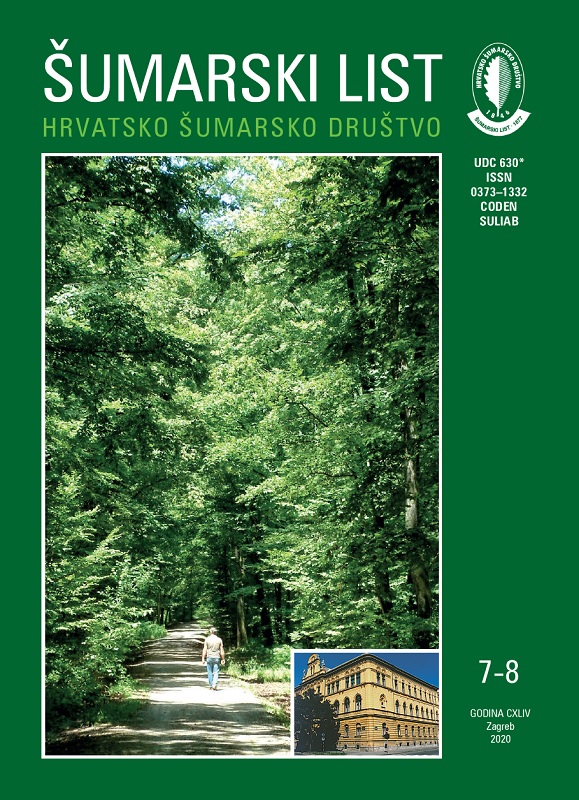
broj: 7-8/2020
pdf (6,01 MB) |
|
||||||||||||||
| RIJEČ UREDNIŠTVA | ||
| Uredništvo | ||
| Parafiscal levies – definition and who should pay them pdf HR EN | 337 | |
| IZVORNI ZNANSTVENI ČLANCI | ||
| Milan Pernek, Marta Kovač, Nikola Lacković | UDK 630* 453 (001) https://doi.org/10.31298/sl.144.7-8.1 | |
| Testing of biological effectiveness of pheromones and traps for catch of mediterranean bark beetle Orthotomicus erosus (Coleoptera, Curculionidae) pdf HR EN | 339 | |
| Mladen Ognjenović, Tom Levanič, Nenad Potočić, Damir Ugarković, Krunoslav Indir, Ivan Seletković | UDK 630* 425 + 111 (001) https://doi.org/10.31298/sl.144.7-8.2 | |
| Interrelations of various tree vitality indicators and their reaction to climatic conditions on a european beech (Fagus sylvatica L.) plot pdf HR EN | 351 | |
| Simon Lendvai, Jurij Diaci, Dušan Roženbergar | UDK 630* 242 (001) https://doi.org/10.31298/sl.144.7-8.3 | |
| Response of black alder (Alnus glutinosa (L.) Gaertn.) to selective thinning of various intensities: a half-century study in northeastern Slovenia pdf HR EN | 367 | |
| Besim Balić, Ante Seletković, Ahmet Lojo, Aida Ibrahimspahić, Jusuf Musić, Admir Avdagić, Velid Halilović | UDK 630* 516 (001) https://doi.org/10.31298/sl.144.7-8.4 | |
| Model for estimation merchantable wood volume of spruce (Picea abies Karst) in Canton 10, Federation of Bosnia and Herzegovina pdf HR EN | 379 | |
| Hüseyin Ogfuz Çoban, Halis Bereket | UDK 630* 432 (001 https://doi.org/10.31298/sl.144.7-8.5 | |
| Visibility analysis of fire lookout towers protecting the Mediterranean forest ecosystems in Turkey pdf HR EN | 393 | |
| Summary Urgent detection of fire and precise identification of its location are of critical importance for success of first response to fight forest fire. Forest fire lookout towers are main observation system and used in a sophisticated way to detect forest fires in Turkey. The objective of this study was to conduct visibility analysis of fire lookout towers deployed in mountainous Mediterranean forest region of Turkey, thereby assess their effectiveness. It is necessary to determine functionality and capacity of these towers to protect forest environment. Visible and invisible areas from towers were identified by using Geographic Information System and high resolution digital elevation data. In visibility analysis, scanning was performed with a rotation of 360 degrees at the 18 kilometres radius from the point where a lookout tower was located. Roads in this region are one of the elements that can be used in fire observation. People traveling on these roads may report forest fires by using cell phones. In this sense, the efficiency/effectiveness of the towers have been associated with forest road traffic. Therefore, visibility analysis of roads was also performed to check the observation capabilities from roads. Although there are 37 fire lookout towers in this area, where coniferous tree species such as brutian pine and black pine that are highly vulnerable to fire are dominantly distributed, 40% of forests are in parts that are not visible and 15% of them are at high risk of fire. More than 100 thousand hectares of fire-sensitive forest area in this region could not be controlled by the towers. The network of towers could view 56% of the overall area and 59% of the forest areas. People using the roads contributed to the lookout system by 11% and ensured that 70% of the forest area in this region was visible when combined with the towers. On the other hand, 59% of 523 thousand hectares of forest land that were not visible from the roads were visible from the towers. It was emphasized that the participatory behavior of people who lived in forests and used inner forest roads were an important part of the fire observation system. We recommend that the GIS-based methodologies including digital camera systems and remote sensing technologies in addition to the conventional lookout towers with a view to planning the economically, technically and operationally optimal fire lookout system. Key words: viewshed analysis; fire risk; fire sensitivity; forest fire; forest road; Isparta | ||
| PREGLEDNI ČLANCI | ||
| Željko Španjol, Boris Dorbić, Nikola Vrh, Ivana Gašparović, Ivan Tolić, Milan Vojinović | UDK 630* 187 + 174 https://doi.org/10.31298/sl.144.7-8.6 | |
| Vegetative and dendrological characteristics of Hober forest park in Korčula pdf HR EN | 409 | |


